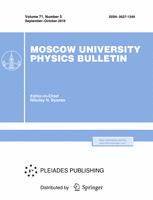The effect of proton irradiation on the process of changes in the surface structure of K-208 glass caused by the formation of microcracks and gas-filled bubbles was studied using atomic force microscopy methods. The K-208 glass plates, which are used to protect solar cells of spacecrafts, were chosen as experimental samples. As a result of the analysis of experimental data obtained by atomic force microscopy, it was found that on the surface of K-208 glass irradiated in vacuum ($10^{-4}$ Pa) by protons with an energy of 20 and 30 keV at a flux density of $\varphi_p =6{,}0 \cdot 10^{10}$ cm$^{-2}$s$^{-1}$ and fluences $\Phi_p = (10^{15} \div 6{,}6\cdot 10^{16})$ cm$^{-2}$ gas-filled bubbles and microcracks are formed, the characteristic sizes of which grow with increasing fluence. It was shown that for the same values of $\varphi_p$ and $\Phi_p$ irradiation of K-208 glass with protons with energy of 20 keV does not lead to the formation of microcracks.
$^1$Department of fundamental science, Faculty of Physics, The Bauman Moscow State Technical University



